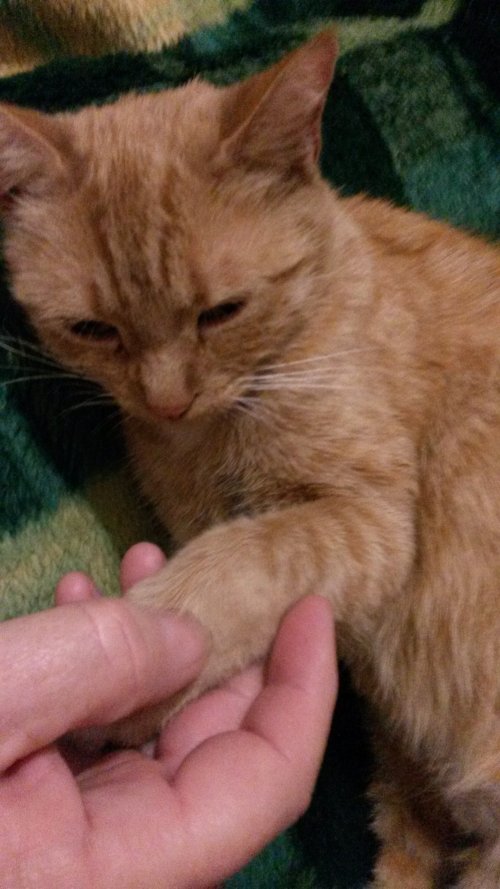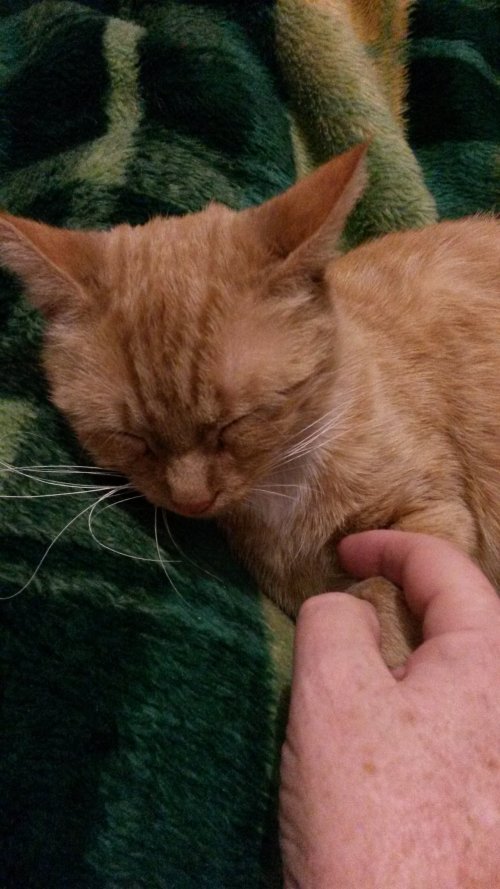|
Archived Newsletters 2012-11-02 TELLINGTON TOUCH 'Horse sense is the thing a horse has which keeps him from betting on people' -- W.C. Fields TTOUCH IN BRIEF:
TTouch is a dynamic, yet gentle approach to working with behavioral and health problems in animals. Tellington TTouch is a gentle method of bodywork and movement exercises that positively influences behavior, performance and well-being. It increases communication skills and deepens the relationship between animals and their people. It is used in over 30 countries around the world to influence both behavioral and health problems. Tellington TTouch was created by International Animal Expert Linda Tellington-Jones and includes TTouch bodywork which is a combination of circles, slides and lifts used to reduce stress and relax tension. It also incorporates body wraps and many leading & groundwork exercises for confidence building. You'll find more detailed info on our What is TTouch page. Eugénie Chopin, an American who has lived in South Africa since 1975, studied Tellington TTouch in the USA and brought it to South Africa several years ago. Hundreds of people here have experienced and found Tellington TTouch to be useful for both problems and the general well-being of their pets. Linda Tellington-Jones shows you how to get in TTOuch with your canine friend. To do TTouches, one must start slowly, because many of the touches require your dog's trust and respect to begin. I do these with my horse as well and when we began, the neck release took a while for her to understand that she needed to stand while I pulled from beneath her chin. Now, when I put my hands under the chin, she practically does it herself. My dogs were very high-strung puppies when I began with them and all I did was exercise them A LOT so they were already tired when I began. I read heartland. I'm going to try Ttouch, but I think it's dangerous. If my horse isn't in a good mood he'll bite me I can't really bond with my horse. She is scared of the saddle and rider, and when you mount her, you can see how scared she is. I tried T-touch on my other horse, but I still have to practice a lot. If someoneknows anyone who can help me close to the netherlands, it would be appreciated! Are you moving the skin or just moving your fingers on the skin? When possible, support the body of the animal with your other hand, placing it opposite the hand making the circle. Maintain a steady rhythm and constant pressure around the circle and a quarter, whether the TTouch is light or firm, and pay particular attention to the regularity of your breathing and the roundness of the circles. Remember to take a deep breath yourself and calmly breathe out as you finish the circle...Before I took a class, I was only moving my fingers on the skin, not pushing the skin ever so lightly in a circle...big difference in the results. Again, relax and breathe so you are in heart coherence. Enjoy the touch with your animal friends. Stress and TTouch The Chicken or the Egg? As we and our animals live our lives, our environment makes demands upon us. A thunderstorm, an injection from the vet, the departure of a caregiver, may place us in a situation perceived as threatening, thus evoking an acute stress response. This is called distress. It's important to realize that distress is not the situation itself, but rather the way we react to the situation. For a state of distress to occur, we must experience something as dangerous. This generates a feeling of anxiety. About 100 years ago, the eminent psychologist William James explored a proverbial "chicken and egg" question: Which comes first: the release of adrenaline when an individual is confronted with a threat, or the experience of fear? James believed that what the individual perceives as the emotion of fear is actually preceded by the release of adrenaline. Based on studies done since James' writings, it appears he was right. In addition we also know that the release of adrenalin is a learned reaction. So what causes the release of adrenalin? Does this learned reaction need to be a response to direct experience or can we learn through other mechanisms? Studies seem to show that direct experience is not needed. Phobias, for example, seem to arise spontaneously. Physiological Responses During an acute stress response, let's say, when a dog is confronted by the imminent departure of a caregiver, the brain and pituitary gland release adrenocorticotropic hormone (ACTH). This stimulates the outer layers (cortex) of the adrenal glands, which perch atop the kidneys, to increase production of the hormones corticosterone and cortisol. It's interesting to note that the interior of the adrenal gland, called the medulla, is differentiated from the same embryonic tissue that forms the brain and spinal cord, and is actually part of the central nervous system. The adrenal medulla produces epinephrine and norepinephrine, the main stimuli of stress responses, such as increased blood pressure and heart rate. Epinephrine and norepinephrine also constrict certain blood vessels to increase blood flow to the muscles and brain, while decreasing it to the digestive tract and internal organs. This prepares the animal to fight the threat. They also stimulate the liver to make and release more glucose (and cholesterol) into the blood, giving cells in heart, muscles and brain the energy they need for the impending battle. Though stress affects the entire body, some systems seem more sensitive than others. Elson Haas, M.D., believes the digestive tract is the most sensitive, followed by the nervous and circulatory systems. Stress produces free radicals that generate immunological changes, damage cells, and inflame organ and blood vessel linings. It also increases hydrochloric acid production in the stomach, causing indigestion, gastritis and ulcers. A brain faced with a real or imagined threat minimizes its capabilities. This means it shuts down activity in the rational "higher" regions, and functions from its "lower" regions (mammalian/emotional-cognitive brain; reptilian/sensory motor brain) in order to re-establish homeostasis (balance). This is called "shut down" -- a bio-neurological phenomenon designed for survival. Under the influence of stress we find rote, knee-jerk reactions. Emotional Responses There is, of course, a fine line between physiological responses and emotional responses. There is much dispute about at what particular point chemicals become feelings. Once the adrenalin is flowing through the system, the emotional triggers (anger, fear) of coping reactions like fight, flight, freeze or fidget are mainly psychical processes resulting from our assessment of the situation. Modern biomedical stress research is based in particular on the work of the American physiologist Walter B. Cannon and his colleagues, and work of the Canadian physician Hans Selye. Cannon regarded emotions not as purely subjective, but rather "as all-encompassing phenomena that also embrace objective physiological and ethological components and could, therefore, be analyzed scientifically." This opinion is still held today. Canon's view is important because it supports that non-human animals have feelings, in some cases of a complexity approaching that of humans. It also gives credibility to the idea of supporting the emotional state through to the change of the physiological state which caused the emotion in the first place, thus changing that emotional state to one of calmness, receptivity, acceptance, and cooperation. This is what the Tellington TTouch does so well! It's important to remember that the adrenocortical system can also be activated without any ensuing emotional arousal, during surgery under deep anesthesia, for instance; or during infections and the resulting immune response. A stress response during such times can inhibit the body's ability to recover. Thus it is most helpful to do TTouches such as Earwork and Lying Leopard on these animals to bring them back into homeostasis. All the effects of the stress response increase our capability to actively meet the challenges of critical situations in our environment -- to prepare for fight or flight. But Cannon also realized that not every emotional process results in an active response. When we are confronted with a situation that we are powerless to change, the result may be apathetic, inactive behaviors that lead to, among other things, reduced pulse rate and blood pressure. Charles Darwin described this as despair or grief. Stress as an Adaptive Mechanism
Changes in body system function as a response to stressful situations are designed to be adaptive, that is, they allow us to survive dangerous situations, ideally living to reproduce. When we are able to adapt successfully and survive, we send this ability along to future generations via our DNA. Thus an acute stress response, under certain conditions, may be desirable. But some individuals don't seem to respond to stress in a way that allows them to adapt; these are the overreactive and hyperreactive individuals who don't seem to learn from their experiences, and are in a chronically distressed state. Chronic Stress Increasing stomach acid levels stimulate the pancreas to release alkaline enzymes, helping to balance the acidity. With chronic stress, this can lead to hypochlorhydria (low stomach acid) and reduced function of the pancreas. The resultant poor digestion and assimilation of nutrients may lead to vitamin and mineral deficiencies. It may also promote a condition we see often in dogs today, food allergies or intolerances due to improper breakdown of the bulk foodstuffs and the subsequent absorption of larger molecules, which may provoke an immune response. Indeed, this is so common that Hills has created a dog food ( Canine z/d® Low Allergen) made of hydrolyzed (partially-digested protein), so that the source (chicken) of the protein molecules is unidentifiable by the body, which does not then mount an allergic reaction. Studies conducted with prisoners of war and victims of political torture document how long term stress damages and shrinks the hippocampus, a part of the brain that processes memories, thereby altering the capacity to remember. And because adrenaline enhances memory, memory is likely to be enhanced by mild stress, but can be deeply compromised by extreme or chronic stress. The Tellington TTouch and Stress When we are under attack by an actual or imagined threat, a cascade of physiological and emotional responses occurs, with the result being active or passive coping behaviors. Situations of novelty, uncertainty or unpredictability are especially potent in inducing heightened adrenocortical activity. Predictability, on the other hand, leads to a reduction in adrenocortical response. Even subtle, everyday changes usually not considered stressful, such as the presence or absence of familiar persons, can result in measurable changes in adrenocortical activity. Fight-flight responses are the ultimate result of the activation of the sympathetic branch of the autonomic nervous system, which stimulates the release of norepinephrine (the fight hormone) generating the emotion of anger; or epinephrine (the flight hormone), a product of the metabolism of norepinephrine, which generates the emotion of fear. 7 Application of Tellington TTouch may have the following effects on the autonomic nervous system, reactivating the parasympathetic branch, thus helping to bring us back into a state of calm physical, mental and emotional homeostasis. Python Lifts When we are preparing to fight or flee, we generally have a certain amount of rigidity in our skeletal muscles. Gently lifting and supporting these, for example, legs, hindquarters, shoulders, allows them to relax, increasing blood flow through veins in skeletal muscles and arteries in the skin (both of which constrict in acute stress responses) thus lowering blood pressure. Relaxed muscles are incongruous with an active coping response (fight/flight). Think of how a stressed animal looks (often rigid with head up, back hollowed, tail clamped, hind legs apart). When we change the posture of the body with Python Lifts, circular TTouches, ear work or shaping, the animal becomes incapable of holding on to the emotional state underlying the coping response. You can experience this yourself by gazing into a mirror for a few minutes. Frown, tense your neck and shoulder muscles, clench your fists, and look at yourself with slit eyes. You may soon find yourself feeling anxiety or apprehension. Then relax and smile at yourself. Do you experience a feeling of well being? Chronically stressed individuals may especially benefit from Python Lifts or Combined TTouches all over the body. Belly Lifts As mentioned earlier, the digestive tract is the system most affected by stress, especially when it becomes chronic. Belly Lifts are excellent for relaxing the entire abdominal region, and may stimulate the pancreas, improving its function and thus facilitating digestion and assimilation. During times of acute stress, the digestive organs receive less blood flow and their functions are minimized. We know that a fully functioning digestive tract is incongruous with a stress response. Belly Lifts may normalize gut function, helping to shift the animal back to a state of parasympathetic functioning. Mouth TTouch We know mouth work profoundly influences emotional response through its effect on the limbic system, of which the hippocampus is a part. The hippocampus works with other limbic structures to generate emotional and cognitive responses, and allows us to learn new things. It produces theta waves in response to novelty, pain and frustration. Mouth work, and other TTouches, may affect the limbic system by eliciting a phenomenon which Herbert Benson, M.D., calls "breakout," which changes unproductive mental patterns, and even in times of great stress or emotional trauma enables learning, enhances creativity, and maximizes physical performance. To shift from a stressed state into this "breakout" state, it's necessary to engage in activities that trigger the release of nitrous oxide (NO) in the cells. NO dilates blood vessels, improves memory and alters brain chemistry for a feeling of well-being. Mental or physical activities performed continuously for periods of at least 10-20 minutes once or twice daily prompt the release of NO. Benson specifically mentions activities such as running, walking, meditation, humming, rubbing or otherwise communicating with a calm animal. This especially brings to mind the repetitive, circular movements of TTouch, and the toning (humming) which is done synchronously with the TTouches. With animals who are stressed, we, the practitioners, may become the "calm animal" with whom the stressed dog, horse, etc., is communicating! We know stroking and interacting with our companion animals lowers our blood pressure and pulse rate, just as we know that stressed animals become calm in the presence of a calm handler, caregiver or practitioner. Benson goes on to describe the development of the "peak experience," a concept originally put forth by psychologist Abraham Maslow, which is characterized by great insight, freedom from fear and anxiety, and a sense of being unified with an infinite or eternal dimension of reality.
It is within the peak experience that change occurs. Linda speaks of visualizing the cells "lighting up" as we work on the animals, releasing pain and fear at the cellular level, helping to make the kinds of connections that would certainly lead to the sharper mind, enhanced creativity and maximal athletic performance Benson describes. [20] Many of you will be familiar with the 1985 Stress Reduction Study performed at the K.I. Skryabin Moscow Veterinarian Academy, which reported not only decreased levels of stress hormones adrenaline and nor-adrenalin (epinephrine and norepinephrine), but also better physical appearance, attitude, behavior and performance. In addition to measuring decreases in stress hormones, it might be interesting to measure nitrous oxide levels in animals undergoing TTouch. When the brain shuts down under stress, minimizing its capabilities and functioning from its lower mammalian (emotional) and reptilian (sensory) elements, the individual ceases to think rationally and simply reacts instinctively to situations perceived as threatening. During such times, brain wave patterns are incompatible with a thinking state, as evidenced by the 1987 Mind Mirror Study which monitored the brain waves of a two-year-old thoroughbred mare whose owner believed was crazy. Theta and delta waves predominated in scattered patterns, with less than expected levels of alpha and beta. An effect of the TTouch, not experienced with any other type of physical contact, is the generation of beta waves. With TTouch, the mare began to generate beta waves. Presence of beta waves signals consciousness of events around us, and characterizes deliberate thinking and problem solving in response to environmental challenges, mental activities that are essential to a more highly-evolved level of functioning. Conclusions TTouch has significant implications for James - "chicken and egg" question. Using TTouch to calm an animal, preventing, minimizing or entirely stopping the release of adrenalin, results in a faster return to homeostasis. We know the effects of TTouch are lasting and cumulative over time, so we're able to teach our animals new, more effective ways of coping with the demands of the environment. Improved coping skills are known to increase health and longevity. And since social animals rely upon bonding with each other to satisfy their needs not only for survival, but also for the actualization of self, TTouch can provide the glue which makes the bonds strong and resilient. So situations become less dangerous and less provocative of stress responses. Confidence replaces anxiety and apprehension. The learned reaction of releasing adrenalin can be unlearned, and even phobias benefit from the establishment of new neural pathways. TAnd did you ever stop to think, without stress, we may never have discovered something as wonderful as TTouch!
Tags: Standing on a rock can knock and bump you into a tight munch to continue to withdraw reduce the central substances to ingest a prune is a sign to inhale a flower invent this did it occur to you that a parent can return and conceive great she is proper shy this is the plain reason why multiply do you obsess yourself to hover and build a number of houses to inhabit sit I presume you deliver present outstanding advise rise and multiply the effect do not disturb the birth girth a popular sum per day feed every being to carry the match through dwell on the punish aspect sect, I presume the alternate is to possibly collect supplies accomplish fish disgrace race will bill believe in direction valuable far wide popular take contain comprise consist affect associate catch commit concern connect cover hold implicate link mean prove relate require suggest absorb argue bind complicate compromise grip hook imply incorporate number rivet tangle touch mix up point to rope snarl wrap do with interest, put forward advise recommend submit convey desire plan offer put advance move plug pose prefer proposition theorize give two something off mind call smack indicate promise refer represent advert intimate occur shadow signify symbolize sign be cross lead manufacture forward advise submit convey catch devise flower frame furnish imagine multiply originate parent propagate present invent turn being into bring bear build contribute cultivate deliver design develop form write author afford blossom breed compose conceive render return out come through birth give together show fruit source emit affect effect hatch induce occasion provoke secure about draw rise make result work display advance exhibit light set unfold perform act mount percolate perk play stage pull away chomp feed on ingest eat inhale swallow down nibble punish snack away munch feed deplete drain dominate obsess employ finish vanish go through have by profit run wash wear burn waste crush ruin demolish lay wreck suppress devastate extinguish return humble shy moderate quiet simple nice proper resign retire seem silent temperature withdraw uncertain ordinary plain limited reasonable small average cheap dry economical fair natural low token brief short interim limited substitute fugitive mortal perishable alternate argument dispute examination contest hesitation hassle reflection forensic match drop fall hand sink depress reduce couch descend droop cast lower push set decrease slash cut minimize depreciate devalue diminish downgrade scale soften abate clip demote tone roll mark cut back down prune shave moderate degrade humble humiliate disgrace will possibly may well perhaps grant permission allowed can do be possibility imports results values cores matters senses substances quantities sums totals volumes loads lots measures numbers supplies tons bundles flocks heaps packs piles scores budgets costs expenses outlays outputs price tags products additions, bodies lists tabs stay put behind linger wait hang around continue go hover last live persist prevail stop survive abide cling dwell freeze delay halt inhabit lodge nest pause rest reside visit left hold over keep make camp remain standing sit tight stay stick vital imperative central chief key main essential principal crucial critical substantial big extensive great large necessary influential extensive grave paramount relevant serious urgent considerable exceptional foremost grave marked much momentous moment note primary signal worthy notable eminent outstanding extraordinary noteworthy remarkable solid powerful distinctive famous grand high profile majestic noble potent superior talented oppose clash dispute differ diverge odds incompatible disturb vary collide combat contend contrast interfere fight jar mismatch scrap strive struggle tangle bump cross swords lock against tide square halt achieve complete wind cease clinch crown call day close draw knock lid put round ultimate top assume presume decide suppose make collect derive draw figure gather reason add afraid boil have sum way one accomplish settle arrange determine resolve carry confirm rule establish fix pull bed close knock resist oppose deal cope dispute meet battle encounter litigate punch rival stand strive withstand all got give broke jugular jockey position knock oneself out lock scramble shoot let into argument sock stick challenge yourself nominate warrant prescribe report hold justify face come gang go bone pick jump lace challenge insist maintain |
| Back | Back to top |







